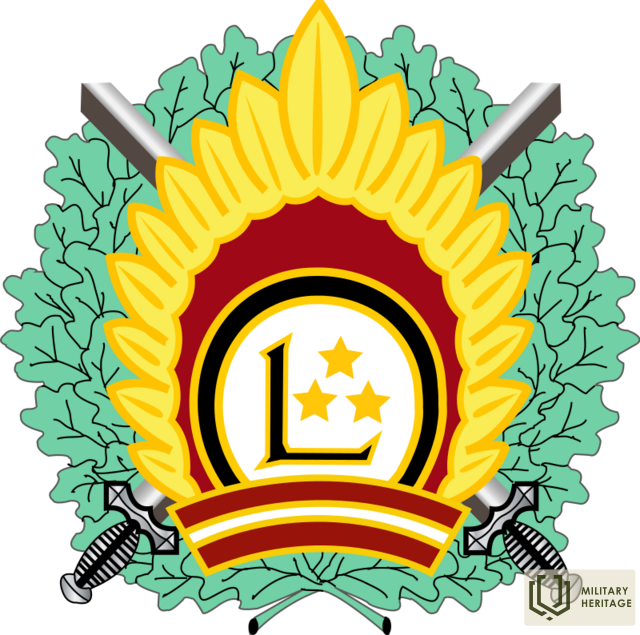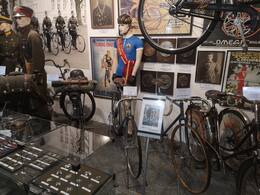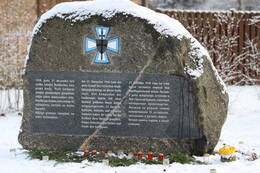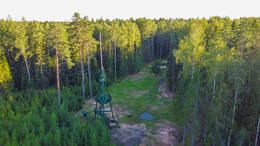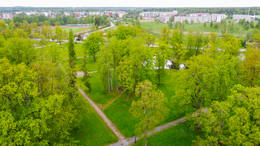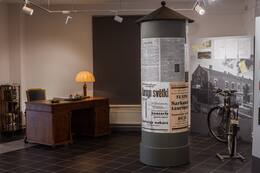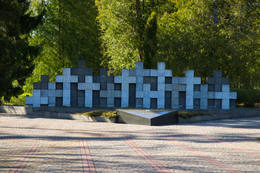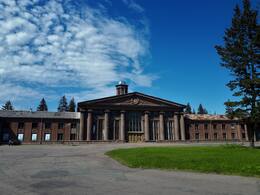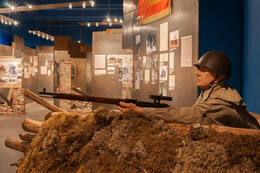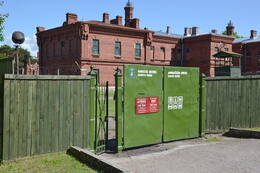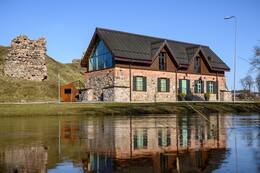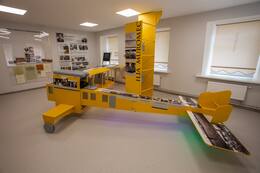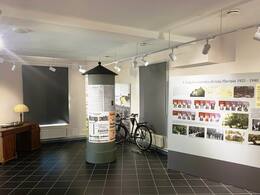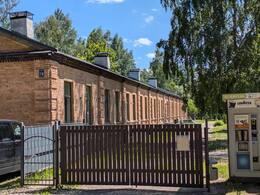Latvijos armija
I Nepriklausomybės karai, Baltijos šalių nepriklausomybė, II WW2
1919 m. sausio 5 d. buvo suformuotas pirmasis didelis nacionalinis karinis vienetas – Atskirasis latvių batalionas, vadovaujamas pulkininko leitenanto Oskaro Kalpako. Šis kovo mėnesį į brigadą reformuotas dalinys kartu su Estijos teritorijoje suburta Šiaurės Latvijos brigada, kuriai vadovavo pulkininkas Jorgis Zemitanas, suformavo Latvijos kariuomenę. Naujai suformuota kariuomenė augo ir grūdinosi mūšiuose su bermontininkais prie Rygos ir Kuršijoje, taip pat mūšiuose su bolševikais Latgalos fronte.
Praėjus savaitei po Pirmojo pasaulinio karo pabaigos ir Kompjeno paliaubų sudarymo 1918 m. lapkričio 11 d., buvo paskelbta nepriklausomos Latvijos valstybės įkūrimas. Naujoji laikinoji vyriausybė tikėjosi, kad gali išsiversti be reguliariosios armijos kūrimo, nes neketino nieko pulti. 1918 m. lapkričio 13 d. Sovietų Rusija anuliavo Brest-Litovsko sutartį, kuria Baltijos teritorijas atidavė Vokietijai, ir pradėjo veržtis į vakarus. Viltys, kad Vokietijos kariuomenė įvykdys savo įsipareigojimą apginti Latviją nuo bolševikų invazijos, nepasiteisino.
Tuo tarpu Rygoje kūrėsi Latvijos Respublikos Laikinajai Vyriausybei lojalūs būriai. 1919 m. pavasarį Latvijos ginkluotąsias pajėgas sudarė Landesveras (Baltijos Vokietijos nacionalinė gvardija), Šiaurės Latvijos brigada ir Pietų Latvijos brigada. Abi šias brigadas 1919 m. liepos 10 d. sujungė generolas Dāvis Sīmansons, tapęs pirmuoju Latvijos kariuomenės vadu. Ši diena laikoma Latvijos kariuomenės įkūrimo diena.
1919 m. Latvijos kariuomenė buvo sparčiai apginkluota ir vystoma, ginklai ir įranga buvo gauta iš Anglijos, Lenkijos ir kitų šalių. 1920 m. pradžioje Latvijos ginkluotosiose pajėgose tarnavo apie 52 000 karių. Nepriklausomybės karas baigėsi 1920 metų rugpjūčio 11 dieną, kai buvo pasirašyta taikos sutartis su Sovietų Rusija. Iš karto po Nepriklausomybės karo Latvijos kariuomenė pradėjo pereiti į taikos meto valstybę. Latvijos armiją sudarė keturios pėstininkų divizijos su trimis pėstininkų pulkais ir po vieną artilerijos pulką. Pėstininkų pulkai buvo sunumeruoti ir pavadinti Latvijos miestų vardais. Latvijos kariuomenė taip pat turėjo karinį jūrų laivyną, kurį sudarė flagmanas „Virsaitis“, povandeninių laivų divizija su dviem povandeniniais laivais „Ronis“ ir „Spīdola“, taip pat Minų divizija su dviem mininiais traleriais „Imanta“ ir „Viesturs“ bei keletu pagalbinių laivų.
Kariuomenės sudėtis buvo suformuota visuotinio šaukimo pagrindu, kuriam buvo pavaldūs visi Latvijos piliečiai. Iki 1931 metų tarnybos laikas buvo 18 mėnesių, vėliau pėstininkams sutrumpėjo iki 12 mėnesių, kitų ginklų šakų – 15 mėnesių. Kariuomenę ir laivyną valdė Karo ministerija. Karo ministras turėjo kariuomenės vadą, kuris buvo atsakingas už kariuomenės mokymą ir parengimą.
1940 m. birželio 1 d. Latvijos kariuomenėje buvo 30 843 vyrai. 1940 m. birželio 17 d., Antrojo pasaulinio karo metais, sovietų kariuomenė perėmė visos Latvijos ir Estijos kontrolę. Latvijos kariuomenė buvo palaipsniui išformuota, latvių kariai buvo išleidžiami į pensiją, suimami ir deportuojami. 1940 09 27 buvo panaikintas Latvijos karo ministro, 1940 10 09 – Latvijos liaudies kariuomenės vado pareigas.
1989 m. birželio 17 d. Rygoje, Latvijos valstybinio universiteto Didžiojoje salėje, įvyko steigiamoji Latvijos šaulių draugijos konferencija. Po to per kelias savaites daugiau nei 500 buvusių karių įstojo į Latvijos šaulių draugiją. Rudenį skyriai ir grupės susikūrė Jelgavoje, Tukme, Liepojoje, Bauskėje, Balvuose, Līvānuose, Maskvoje ir kitur. Pradedamas aktyvus darbas kuriant ir plėtojant įstatymus, reglamentus, įvairius dokumentus, kurie bus reikalingi kariuomenės kūrimui ir egzistavimui.
1991 metų rugsėjo 10 dieną buvo priimtas įstatymas dėl privalomosios valstybinės karo tarnybos. Dėl šio įstatymo privalomąją karo tarnybą privalo atlikti visi 19-50 metų Latvijos piliečiai vyrai. Netrukus po šio įstatymo priėmimo, lapkričio 11 d., Brolių kapinėse buvo duota pirmoji kario priesaika nuo Latvijos nepriklausomybės atkūrimo.
Daugiau informacijos šaltinių
1. 100 įvykių Latvijos istorijoje. Žmonės ir procesai 1918-2018 m. UAB „Latvijas Mediji“, 2018 m.
2. Sielų pūga. Skaitmeninis muziejus. Prieiga: https://www.dveseluputenis.lv/lv/laika-skala/notikums/105/sarkanas-armijas-iebrukums-latvija/ [žiūrėta: 2021 05 08.].
3. Nacionalinių ginkluotųjų pajėgų svetainė. Prieiga: https://www.mil.lv/lv/par-mums/vesture [žiūrėta 202 05 08
Susijusios vietos
Karinių motociklų ekspozicija Saulkrastų dviračių muziejuje
Dviračių muziejus yra Saulkrastuose, netoli A1 greitkelio ir Pabaži geležinkelio stoties, šalia Baltosios kopos. Muziejaus kolekciją sudaro techniškai įdomiausi dviračių raidos istorijos pavyzdžiai Latvijoje. Tai didžiausia dviračių kolekcija Baltijos šalyse, kurioje yra apie 60 Latvijoje pagamintų ir naudotų dviračių, įskaitant armijos tipo dviračius. XX amžiaus pradžioje daugelis armijų pradėjo plačiai naudotis dviračių prieinamumu ir privalumais. Dėl jų mobilumo buvo suformuoti specialūs dviračių daliniai. Dviračių daliniai galėjo lengviau rinkti žvalgybos informaciją ir pradėti netikėtus išpuolius, be to, jie buvo mobilesni nei įprasti pėstininkai, kai reikėjo vykdyti operacijas plačioje teritorijoje. Po Pirmojo pasaulinio karo Latvijos armija taip pat turėjo dviračių dalinių, kurie naudojo Latvijoje pagamintus armijos dviračius. Kiekvienas tokiame dviračių dalinyje tarnavęs kareivis turėjo atitikti griežtus reikalavimus. Būtina gera ištvermė, regėjimas ir klausa, taip pat sveika širdis ir plaučiai. Jie negalėjo sverti mažiau nei 80 kg, o jų ūgis turėjo būti 165–180 cm. Latvijos armijoje buvo laikomasi standarto, kad gerai apmokytas dviratininkas per dieną turėtų įveikti 80–100 km, o priverstinėmis sąlygomis – iki 150 km. Žiemą, kai nebuvo galima naudoti dviračių, buvo naudojamos slidės. Dviračių būrio kareivis turėjo sugebėti per dieną nučiuožti 50–60 km. Daugelis dviračių būrių kareivių vėliau tapo profesionaliais sportininkais.
Kasmet sulaukiame apie 5000 lankytojų.
Paminklas pirmajam mūšiui už Latvijos nepriklausomybę
Adresas: Inčukalns, Atmodas g. 2.
2016 m. liepos 3 d. buvo atidengtas paminklas pirmajam mūšiui už Latvijos nepriklausomybę, skirtas Latvijos landesverui (Die Lettländische Landeswehr), kuriame vietos baltų vokiečiai, rusai ir latviai, tuo metu buvę abiejų pusių daliniuose, gynė naujai įkurtą valstybę nuo bolševikų Raudonosios Armijos. Brolių kapų komiteto pirmininkas Eiženas Upmanis tuo metu padarė išvadą, kad tai galėtų būti pirmasis paminklas jungtinėms Latvijos ir Baltijos vokiečių pajėgoms mūšio memorialuose už kapinių ribų. Tuo metu Latvijos landesvero latvių dalinių vadu buvo paskirtas pulkininkas leitenantas Oskaras Kalpaksas, iš kurio dalinių Laisvės kovų metu išaugo ir susiformavo vėlesnė Latvijos armija.
1918 m. visa dabartinės Latvijos teritorija pateko į Vokietijos imperijos ir jos kariuomenės rankas. Tačiau 1918 m. vasaros pabaigoje ir rudenį padėtis ėmė sparčiai keistis prieš Vokietiją ir tapo aišku, kad tik laiko klausimas, kada Vokietija bus priversta pripažinti pralaimėjimą Pirmajame pasauliniame kare. Rusijos imperija, kurios dalimi Latvija buvo iki Pirmojo pasaulinio karo, nustojo egzistuoti anksčiau, po 1917 m. vasario ir spalio revoliucijų. 1918 m. lapkričio 18 d. buvo paskelbta Latvijos Respublika. Vokietijos kariuomenė, kuri po 1918 m. lapkričio 11 d. paliaubų su Antantės valstybėmis buvo dislokuota Latvijos teritorijoje, nebebuvo motyvuota tolesniems karo veiksmams, ir dauguma jos kareivių tiesiog norėjo grįžti į tėvynę.
Tokiomis aplinkybėmis buvo akivaizdu, kad Latvijos gynyba pirmiausia priklausė nuo pačių Latvijos gyventojų suformuotos nacionalinės gvardijos. Iš pradžių, dėl savo išsilavinimo ir santykinai didesnio gebėjimo savarankiškai organizuotis, didžiausią iniciatyvą formuojant tokią nacionalinę gvardiją rodė Latvijoje gyvenantys Baltijos vokiečiai. Į nacionalinę gvardiją įstojo ir Rusijos kareiviai. Siekdama užtikrinti nacionalinės gvardijos aprūpinimą uniformomis, ginklais ir kitais reikalingais ištekliais, Latvijos laikinoji vyriausybė 1918 m. gruodžio 7 d. sudarė susitarimą su Vokietijos atstovu Augustu Vinnigu, numatantį nacionalinės gvardijos aprūpinimą iš Latvijos teritorijoje esančių Vokietijos armijos rezervų. Šiame susitarime, be kita ko, buvo nurodyta, kad ši nacionalinė gvardija, oficialiai vadinama „Latvijas zemessardze“ arba vokiškai „die Lettländische Landeswehr“, bus Latvijos Respublikos ginkluotosios pajėgos.
Latvijos nacionalinė gvardija susidūrė su dviem Latvijos raudonųjų šaulių pulkais (t. y. maždaug 2000–3000 karių), kurie anksčiau buvo patyrę Pirmajame pasauliniame kare ir Rusijos pilietiniame kare. Nepaisant Raudonosios armijos patirties ir skaitinės persvaros, Latvijos nacionalinė gvardija dvi dienas laikė Inčukalną įnirtingose kovose, kol galiausiai 1919 m. sausio 1 d. vakarą, norėdama išvengti apsupties, buvo priversta trauktis, praradusi 43 žuvusius ir kelis sužeistuosius, kurių dauguma buvo bolševikų sučiupti, kur žuvo arba mirė nuo bado ar ligų.
Autorius: Artis Buks. Medžiaga: lauko akmuo. Paminklas pagamintas iš didelio monolitinio akmens, rasto Ruļļuose netoli Jelgavos.
Latvijos kariuomenės vasaros stovykla Litenėje
Latvijos armijos vasaros stovykla Litenėje įsikūrusi miške, Litenės valsčiuje, netoli Pededzės upės. Litenės stovyklos ištakos siekia 1935 m., kai buvo pradėtas Latvijos armijos Latgalos divizijos vasaros stovyklos komplekso statyba. Nuo gegužės iki rudens Litenėje keli tūkstančiai kareivių mokėsi kovos taktikos ir šaudymo įgūdžių. 1941 m. vasarą Latvijos armijos karininkus Litenės armijos vasaros stovykloje suėmė Raudonosios armijos ir NKVD kariuomenės daliniai. Keletas karininkų buvo sušaudyti vietoje, kiti ištremti į Sibirą. 1941 m. birželio 14 d. mažiausiai 430 karininkų buvo suimti ir ištremti į Sibirą į Litenės ir Ostroviečių stovyklas, esančias maždaug už 10 kilometrų nuo Litenės. Vienintelis išlikęs istorinis stovyklos pastatas yra maisto sandėlis. Iš kitų pastatų išlikę tik pamatai. Yra apžvalgos aikštelė su Latvijos vėliava, suolai ir gerai prižiūrima laužavietė. Gynybos ministerijos ir Nacionalinių ginkluotųjų pajėgų remiant, buvo įrengta demilitarizuota patranka. Pastatyti informaciniai stendai. Su Litenės stovyklos įvykiais taip pat susijęs Skausmo sienos memorialas Litenės kapinėse. Latvijos armijos „YouTube“ kanale yra vaizdo įrašas pavadinimu „Litene, Latvijos armijos Katynė“.
Latvijos karinės aviacijos oro uostas
Įsikūręs Vecgulbenės dvaro teritorijoje – istoriniame centre.
Tarpukariu Gulbenėje buvo įsikūręs Latvijos armijos garnizonas, kuriame buvo dislokuotas 7-asis Siguldos pėstininkų pulko batalionas. Ketvirtojo dešimtmečio viduryje pradėta kurti karinė aviacijos bazė, nes sėkmingam karinės aviacijos veikimui net taikos metu turi būti užtikrintas platus aerodromų tinklas. Aerodromai ypač svarbūs tose vietose, kur įkurtos svarbios geležinkelio ir kelių sankryžos. 1935 m. lapkričio 11 d. čia pradėtas karinio aerodromo statymas. 1937 m. Gulbenėje buvo dislokuotas naujai suformuotas Aviacijos pulko dalinys, kuris tapo 6-uoju Latgalos divizijos žvalgybos eskadrile, padidindamas armijos dalinių skaičių prie rytinės Latvijos sienos.
Matosi oranžerijos pastatas.
Paroda „Latvijos armija Pliavinėse XX amžiuje“.
Adresas: Odzienas g. 2, Pļavinės.
Eksponuojama nuolatinė ekspozicija „Latvijos armija Pliavinėse XX amžiuje“.
Pastatas Pliavinėse, Odzienos gatvėje 2, turi ilgą istoriją – nuo tada, kai „Stukmaņi“ didmenininkas „Hugo Apeltofts“ pradėjo jame aktyvią ūkinę veiklą ir taip prisidėjo prie Pliavinių miesto plėtros, iki to momento, kai Nepriklausomybės karo metu čia buvo įkurtas Latvijos Rytų fronto štabas. 1919 m. būtent iš Pliavinių buvo vadovaujamos Latvijos armijos dalinių operacijos prieš Raudonąją armiją Latgaloje.
1934 m. prie šių namų buvo atidengta memorialinė lenta su užrašu: „1919 m. šiuose namuose buvo įsikūręs Rytų fronto štabas, o čia generolas Janis Balodis perėmė vyriausiąją Latvijos nacionalinės armijos vadovybę.“ Sovietų valdžia ją 1940 m. pašalino ir sunaikino, tačiau 1990 m. birželio 16 d., padedant Latvijos nacionalinės išlaisvinimo armijos Pliavinės skyriui, ji buvo atstatyta.
Dabar šalia buvusio štabo pastato stovi memorialinė stela, skirta 15 Lačplėsio Karo ordino riterių, gimusių Pliavinos krašte, o patalpose sukurta paroda „Latvijos armija Pliavinoje XX amžiuje“, kurioje pasakojama apie Laisvės kovų įvykius, Latvijos armijos 3-iosios Latgalos divizijos štabo veiklą Pliavinoje, taip pat galima susipažinti su Lačplėsio Karo ordino riterių gyvenimo istorijomis.
Netoli parodų pastato yra Latgalos divizijos štabo pastatas, kurį 1913 m. kaip „Stukmanu“ likerio fabriką pastatė grafas Teodoras Medemas. 1919 m. jį perėmė P. Stučkos režimas, kuriame taip pat buvo įkurtas kalėjimas. Išvijus bolševikus, 1925 m. pastatą perėmė Latvijos armija, kurioje buvo įsikūręs Latgalos divizijos štabas. Šiame pastate savo karinę karjerą praleido 10 Latvijos armijos generolų ir kitų karininkų. 1940 m. pastatą perėmė Raudonoji armija. Pokario metais jame buvo įsikūrusi mokykla, taip pat savivaldybė. Apie 1970 m. pastatą pradėjo naudoti gamybos susivienijimas „Rīgas Apērbs“.
Parodą būtina apžiūrėti iš anksto telefonu 28442692.
Memorialas „Skausmo siena“
Litenės kapinėse randama meno kūrinių.
2001 m. birželio 14 d. Litenės kapinėse buvo atidengtas architektų Dinos Grūbės, Benitos ir Dainio Bērzinių, akmenkalių Ivaro Feldbergo ir Sandro Skribnovskio sukurtas memorialas „Skausmo siena“. Jis simbolizuoja 1941 m. žuvusių karių poilsio vietą. 1988 m. spalį buvusios Latvijos armijos vasaros stovyklos teritorijoje Sita siloje, Litenės parapijoje, rasti 11 karininkų, kuriuos 1941 m. birželį nužudė sovietų armija, pelenai. Nors jų atpažinti nepavyko, 1989 m. gruodžio 2 d., po pašventinimo pamaldose Gulbenės evangelikų liuteronų bažnyčioje, jie buvo iškilmingai perlaidoti Litenės kapinėse.
11 baltų kryžių, atminimo lenta ir informaciniai stendai.
Pagalvės oro uostas
Įsikūręs Rygoje, Pārdaugavoje, Spilvės pievose netoli Iļģuciems.
Spilvė karinio paveldo istorijoje garsėja ambicingu Spilvės mūšiu XVIII a. ir Spilvės aerodromas. Nuo XX amžiaus jis buvo naudojamas orlaivių bandymams, o Pirmojo pasaulinio karo metais tapo Latvijos aviacijos istorijos liudininku.
Pirmojo pasaulinio karo metais Spilvės pievas naudojo Rusijos kariuomenės oro pajėgos kovoje su vokiečių kariuomene. Sukūrus Latviją, aerodromas tapo svarbiausia šalies oro pajėgų baze ir pilotų poligonu. Ankstesni oro uosto pavadinimai buvo „Spilvės oro uostas“ arba „Rygos oro uostas“, vėliau „Rygos centrinis oro uostas“. Tai buvo pagrindinis oro uostas Latvijoje iki Rygos oro uosto atidarymo 1975 m.
Galbūt prie įspūdingų ne vieno Latvijos piloto pasiekimų prisidėjo prie Rygos esantis Spilvės aerodromas ir svajonė pasiekti žvaigždes. Galbūt, tačiau Latvijos aviacijos užuomazga gerokai senesnė ir ją galima rasti Priekulėje, kur latvių kalvis Zviedris savadarbiu aparatu išskrido iš bažnyčios bokšto.
Šiandien Spilvės oro uostas veikia. Galima pamatyti 1954 metais pastatytą oro uosto pastatą, kuris įkūnija sovietinį klasicizmą arba „Stalino imperijos“ stilių.
Šaltiniai:
Irbītis, K. Latvijos aviacija ir jos pradininkai. Ryga: Mokslas, 2004.
Brūvelis, E. Latvijos aviacijos istorija: 1919-1940. Ryga: Mokslas, 2003.
Oficiali valstybinės agentūros „Civilinės aviacijos agentūra“ svetainė. Prieiga: https://www.caa.gov.lv/lv/latvijas-aviacijas-vesture-isuma [žiūrėta 2021 02 22].
Latvijos karo muziejus
Latvijos karo muziejus yra įsikūręs senamiestyje, netoli Laisvės paminklo, istoriniame gynybos pastate, vadinamame „Parako bokštu“. Muziejuje yra 11 eksponatų. Čia eksponuojami įvairūs ginklai, dokumentai, uniformos, apdovanojimai, ženkleliai ir kiti daiktai, pasakojantys apie kasdienį kareivio gyvenimą kare. Latvijos karo muziejus yra vienas seniausių muziejų Latvijoje. Jo ištakos siekia Pirmąjį pasaulinį karą. Muziejaus kolekciją daugiausia sudarė asmeniniai kareivių daiktai arba mūšio laukuose rasti daiktai. Latvijai atgavus nepriklausomybę, pagrindinis muziejaus tikslas tapo sukurti ekspoziciją apie Latvijos karo istoriją ir aktyvų gyventojų vaidmenį saugant savo žemę. 1937 m. muziejus buvo išplėstas ir techniškai buvo vienas moderniausių tuo metu Europoje. Parako bokštas buvo vienas iš Rygos įtvirtinimų bokštų. Kai kurie įrodymai siekia 1330 m., kai jis buvo minimas kaip „Smėlio bokštas“. Bokštas buvo sugriautas 1621 m., kai Rygą apgulė Švedijos armija. Tačiau 1650 m. buvo pastatytas naujas bokštas parakui ir ginklams laikyti. Nugriovus miesto įtvirtinimus, Parako bokštas išlieka vienu svarbiausių Rygos gynybos sistemos įrodymų.
Laisvosios valstybės brangenybių namai
Nepriklausomos valstybės palikimą saugantys namai yra šalia Rėzeknės pilies griuvėsių.
Išskirtinėje ekspozicijoje pristatoma keli šimtai istorinių eks ponatų iš Latvijos ir užsienio privačių kolekcijų, apimančių 1918–1940 m. laikotarpį, bei skirtingus Latgalos ir Rėzeknės istorijos puslapius. Supažindinama su Pirmosios nepriklau somos Latvijos valstybės karinių ir civilinių apdovanojimų istorija, įvairių valstybinių ir visuomeninių organizacijų vei kla, vykusia nuo Latvijos nepriklausomybės karo iki Antrojo pasaulinio karo.
Tai didžiausia Latvijoje kolekcija, pristatanti nepriklausomos valstybės karinius ir civilinius apdovanojimus bei skiriamuo sius ženklus. Antrajame aukšte įrengta keičiamų parodų salė, kurioje bent kartą per metus surengiama nauja paroda.
Lankyto jai jau turėjo galimybę pamatyti išskirtinę porceliano dirbi nių kolekciją, prabangius laikrodžius iš Prancūzijos ir įvairius Latgalos peizažus vaizduojančius paveikslus
Preilių istorijos ir taikomosios dailės muziejaus ekspozicija „Jazepas Baško – vežėjas oru“ (Jāzeps Baško – gaisa fūrmanis)
Ekspozicija „Jazepas Baško – vežėjas oru“ skirta lakūnui, eska drilės „Iļja Muromec“ vadui ir Latvijos karinių oro pajėgų orga nizatoriui, generolui Jazepo Baško, minint jo 125-ąsias gimimo metines bei Pirmojo pasaulinio karo 100-metį. Muziejaus fonduose saugoma ekspozicija – tai ir dizaino objektas: šešis kartus sumažintas lėktuvo „Ilja Muromec“ ma ketas, su kuriuo pateikiama informacija tekstų ir vaizdų pavi dalu. Paroda papildyta Latvijos karo muziejaus eksponatais ir nauja archyvine medžiaga, gauta iš Latvijos valstybinio istorijos archyvo, Spilvės aviacijos muziejaus ir privačių asme nų archyvų. Jazepas Baško pelnytai laikomas vienu labiausiai apdovano tų latvių lakūnų ir vienu iš pasaulinės aviacijos pradininkų.
Su lėktuvu „Ilja Muromec“ jis pasiekė keturis pasaulio aviacijos rekordus, o jo pavardė įrašyta į Louis Blériot Garbės knygą Paryžiuje – geriausių pasaulio lakūnų sąrašą. Jazepas Baško buvo apdovanotas visais tuometės carinės Rusijos ordinais, taip pat Latvijoje – Trijų žvaigždžių 3-iojo laips nio ordinu, Viesturo 2-ojo laipsnio ordinu, Gynėjų nuopelnų kryžiumi bei aukščiausiais Čekoslovakijos, Estijos, Suomijos ir Lenkijos apdovanojimais. Jis tarnavo carinės Rusijos kariuomenėje, bolševikų Raudo nojoje armijoje, o nuo 1921 m. – Latvijos kariuomenėje. Po Latvijos okupacijos buvo atleistas iš tarnybos
Ekspozicija „Latvijos kariuomenė Pliaviniose XX a.“
Ekzpozicija, skirta Latvijos kariuomenės kūrimosi istorijai, yra Pliaviniose. Pastatas, kuriame ji įrengta, turi ilgą istoriją. Kai buvo pastatyta Stukmanių (dabar Pliavinių) geležinkelio stotis, visoje apylinkėje buvo pradėti statyti namai. Vienas jų, pastatytas 1900 m., buvo pirklio Hugo Apeltofto namas. Iš pradžių statytas kaip pirklių namas, vėliau tapo vieta, kur pradėta formuoti Latvijos kariuomenė. 1919 m. liepą, vykstant Nepriklausomybės karams, čia įsi kūrė Latvijos rytų fronto štabas. 1934 m. birželio 17 d. minint šį istorinį įvykį, ant pastato buvo atidengta atminimo lenta su įrašu: „Šiame name 1919 m. buvo įsikūręs Rytų fronto ka riuomenės vado štabas, ir iš čia Janis Baluodis vadovavo kaip Latvijos nacionalinės kariuomenės vadas.“ 1990 m. birželio 16 d. atminimo lenta buvo restauruota. 2019 m. bir želio 10 d. priešais buvusio štabo pastatą buvo pastatyta atminimo stela, skirta Pliavinių apylinkėje gimusiems kovo tojams, apdovanotiems Lačplėsio karo ordinu. Ekspozicijoje įrengti informaciniai stendai su istorinėmis nuotraukomis, žemėlapiais ir informacija apie Latvijos Rytų fronto štabo formavimąsi.
Latgale Artillery Regiment Army Barracks
The Latgale Artillery Regiment Army Barracks were built as a three-story modern building according to the project of architect Verners Vitands in 1931. This monolithic reinforced concrete building was one of the first in Latvia. They have survived, located in the territory of the Krustpils Manor, next to the castle park. Today, the three-story building that has survived is the unmanaged property of the Jēkabpils municipality. Window openings without windows, entry into the building is not possible, the building can be viewed from the outside. The municipality has carried out roof replacement work. In the future, it is planned to renovate the building by placing various organizations there, and hand it over to entrepreneurs for use.
The Latgale Artillery Regiment consisted of two divisions, each division had two cannon and one howitzer battery, totaling 16 cannons and eight howitzers in the regiment. The remaining artillery units assigned to the regiment were stored in preserved warehouses and were intended for the formation of a third division in case of war.
Riga Garrison Army Tent Camp
Now there are bushes and thickets here, but in the thirties of the last century, the Riga garrison army summer camp was located here. In some places you can still see what look like rectangular ramparts. In these places there were soldiers' tents, arranged in four long rows, with small streets in the middle. At the ends of the rows stood the logos of the garrison units - they were cast from concrete, but the ornaments and inscriptions were made of small, colorful stones. The ramparts around the tents were necessary not only to retain moisture, but also for military purposes. If landing troops entered Mangaļsala, they would be used as trenches under the cover of which to protect the territory from the enemy. Although real military training was taking place here, a romantic idyll reigned in the air, which is also visible in photographs of the time. Young people played volleyball. In the courtyards of the officers' cottages, gazebos and flower beds were well-groomed. The soldiers were visited by their loved ones on weekends, bringing baskets of strawberries and fresh bread. Most meals were eaten outside at tables in the fresh air.
Army town
In this area, in the late 1920s and early 1930s, the Latvian army built an army camp for officers and soldiers who worked on Mangalsala. Later, the camp, along with the Mangalsala military base, became the property of the Soviet Union. Civilians without a certain status lived here, but later social apartments were created for low-income people. On the right side there was a football field and small gardens, but over time they turned into meadows and swamps. Later, private houses and a car service appeared here. Until the 1960s, Mangalsala was not part of Riga at all, but part of Mangali parish. At that time, people here were engaged in fishing or worked at the army base, because agriculture was practically impossible – the arable land area on Mangalsala is only 3.8%. Once upon a time, a narrow-gauge railway ran through the camp right along Mangalsala Street, but the street itself was paved. Now the pavement is hidden under a layer of asphalt. At the end of the road is the port area and the former military pier. Army ships were once moored there, and footbridges were built between them.
Can be seen from the outside, walking along Mangaļsalas Street.
Susijusi istorija
Apie pirmąjį Latvijos kariuomenės vadą Dāvidą Sīmansoną
Knygoje „Latvijos kariuomenės vadai“ esantys rašiniai įtikina, kad istorijai didelę įtaką daro konkretūs asmenys. Nors svarbiausių istorinių įvykių epicentre jie buvo neilgai, tikri Latvijos patriotai, turėdami turtingą karinę patirtį, sugebėjo daug nuveikti formuojant ir stiprinant Latvijos kariuomenę bei istorinių įvykių lūžio momentuose.
Ši istorija pasakoja apie pirmąjį Latvijos kariuomenės vadą Dāvidą Sīmansoną (1859-1933).
Latvijos kariuomenės generolo, dukart Lāčplėsio karo ordino kavalieriaus Pēterio Radzinio atminimui.
Generolas Pēteris Radziņš gimė Lugažų valsčiuje, Valkos rajone, paprastoje ūkininko šeimoje, kur išmoko dirbti ūkio darbus. Jis buvo labai protingas jaunuolis, baigęs mokyklą apsisprendė kariauti ir taip pradėjo savo kariuomenės kelionę, gelbėdamas Latviją nuo Bermonto kariuomenės. P. Radziņš buvo vienas iškiliausių Latvijos kariuomenės karininkų, apdovanotas daugybe Latvijos ir užsienio ordinais bei atminimo medaliais.
Kariuomenės buvimas Mangalsaloje
Ryškūs įspūdžiai iš Latvijos kariuomenės buvimo Mangaļsaloje yra ryškūs mano prisiminimuose. Aprašyti fortai bei Sapieri pastatytas gelžbetoninis įtvirtinimas. Prisiminimai aprašo karių kasdienybę, gyvenimo ritmą, iliustruoja Mangalsalos aplinką. Lanko Mangaļsala ir Latvijos kariuomenės kariai
Prisiminimai apie Karo muziejaus kūrimo pradžią
Pasakotojas aprašo aplinkybes, kuriomis buvo įkurtas Karo muziejus. Minėtos problemos ir surinkimo darbai.
Jungtinės aviacijos šventė – tikra nacionalinė šventė
Pasakotojas aprašo vieną populiariausių ir gausiai lankomų Latvijos renginių – Aviacijos šventę Spilvėje. Aprašoma šventės eiga ir apimtis. Akcentuojamas aviacijos populiarumas Latvijoje.
Apie Sidabrinės kalvos atidarymo šventę
Ištrauka iš prisiminimų istorijos iš generolo Jāņo Baložo kalbos Sudrabkalninio paminklo atidengimo dieną. Visas tekstas yra atidarymo renginio atpasakojimas, prezidento Kārlio Ulmanio ir generolo Jāņo Baložo kalbos. Prisiminimai pasirinkti, nes juose vaizdingai matyti Sudrabkalnino apylinkėse kovojančios Latvijos kariuomenės būklė.
Apie Daugavgrivos tvirtovę
Pasakotojas aprašo įvykį Daugavgrivos tvirtovėje I pasaulinio karo metais, kai ją subombardavo vokiečių dirižablis. Tvirtovė buvo vienas iš strateginių objektų, išlaikęs savo svarbą iki Antrojo pasaulinio karo pabaigos.




